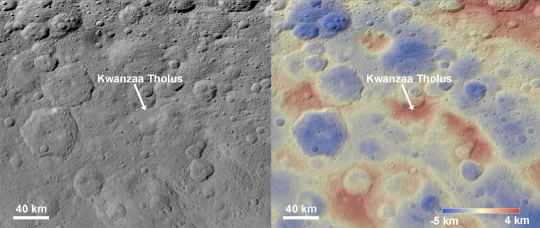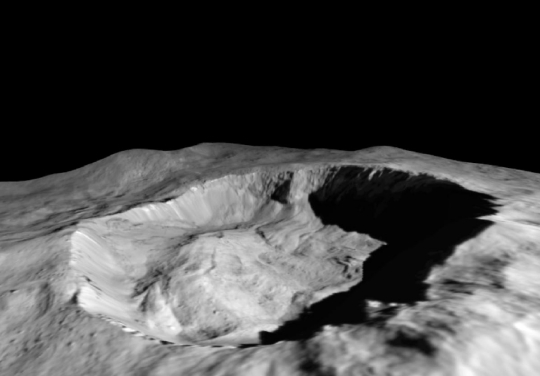I’m looking forward to the buildup as New Horizons gets ever closer to Kuiper Belt Object MU69 and whatever surprises will attend the flyby. But the ongoing operations of the Dawn spacecraft orbiting Ceres equally command the attention. The image below is one of the first images Dawn has returned in more than a year, a stark view of surface features taken on May 16 of this year. The altitude here is 440 kilometers — for scale, the large crater near the horizon is about 35 kilometers wide. The foreground crater is about 120 kilometers from that crater, within a jumbled landscape suggestive of ancient terrain underlying the more recent impact.

Image: On the way to its lowest-ever and final orbit, NASA’s Dawn spacecraft is observing Ceres and returning new compositional data (infrared spectra) and images of the dwarf planet’s surface, such as this dramatic image of Ceres’ limb. Dawn has returned many limb images of Ceres in the course of its mission. These images offer complementary perspective to the images generally obtained by imaging the surface directly beneath the spacecraft. Credit: NASA/JPL-Caltech/UCLA/MPS/DLR/IDA.
As with Pluto/Charon, so with Ceres — we’ve named many surface features, and can thus say that the image, a view of terrain at 23 degrees north latitude, 350 degrees east longitude, is in the neighborhood of mountainous terrain that includes Kwanzaa Tholus. A tholus is a type of small mountain — we now have six named tholi and montes, somewhat bigger mountains, in this region of the dwarf world.
Backing out the view in the image below, you can see Kwanzaa Tholus marked at image center, though its gradual rise makes it difficult to pick out. Here we’re looking at a 2017 mosaic taken by Dawn in its high-altitude mapping orbit at about 1470 kilometers above the surface.

Image: Scientists say Kwanzaa Tholus may have once been as prominent as Ahuna Mons, the tallest and most noticeable mountain on Ceres. Ahuna Mons is likely a cryovolcano, a volcano formed by the gradual accumulation of thick, slowly flowing icy materials. Because ice is not strong enough to preserve an elevated structure for extended periods, cryovolcanoes on Ceres are expected to gradually collapse over tens of millions of years. This means Kwanzaa Tholus and other tholi in that area could be degraded mountains, which also formed from cryovolcanic activity. Credit: NASA/JPL-Caltech/UCLA/MPS/DLR/IDA.
But back to the present, for Dawn is drawing closer to Ceres as it moves into its final orbit, which it will reach in early June. This orbit will take the spacecraft as close as 50 kilometers above the surface, so we can expect the spectacular imagery to continue. It’s worth noting how complex this orbital adjustment is, involving examination of more than 45,000 possible trajectories before engineers chose the final plan. Along with the images, Dawn will be collecting gamma ray and neutron spectra (using the GRaND gamma ray and neutron detector instrument) by way of gaining insights into the chemical makeup of Ceres’ upper crust.
“The team is eagerly awaiting the detailed composition and high-resolution imaging from the new, up-close examination,” said Dawn’s Principal Investigator Carol Raymond of NASA’s Jet Propulsion Laboratory, Pasadena, California. “These new high-resolution data allow us to test theories formulated from the previous data sets and discover new features of this fascinating dwarf planet.”

We’re now going into what is known as XM07, or extended mission orbit 7, a designation that, as mission director and chief engineer Marc Rayman wryly observes, “illustrates the team’s flair for the dramatic.” Since XM05 the spacecraft’s orbit has been elliptical, for Dawn was not designed to operate at low altitude, and we’re dealing with a spacecraft whose reaction wheels have failed, making controlling its orientation an issue. Dawn must fire its small hydrazine-fueled thrusters to control its orientation in space. In his JPL blog, Rayman describes the orbit:
Although the elliptical orbits introduce many new technical challenges for the team, Dawn still takes a spiral route from each orbit to the next, just as it did earlier at Ceres and at Vesta when the orbits were circular. In essence, the ion engine smoothly shrinks the starting ellipse until the new ellipse is the size needed. These trajectories are very complicated to plan and to execute, but with the expert piloting of the experienced team, the maneuvering is going very well.
Image: Mission director and chief engineer Marc Rayman, whose mission updates are indispensable for anyone following Dawn. Both Dawn and New Horizons have done a superb job in keeping mission activities visible to the public. Credit: JPL.
The XM07 ellipse will take Dawn from less than 50 kilometers back out to 4,000 kilometers, with each revolution lasting 27 hours and 13 minutes. Rayman notes that XM07 will place extreme demands on Dawn’s photography because of the high speed of the spacecraft this near to the surface and the pointing problems involved in capturing a specific target. For more on this and a full description of XM07 and its consequences, I’ll send you to Rayman’s blog, which in any case should be on your radar as an informative and witty look deep inside the mission.

Image: This view of Juling Crater was constructed from pictures Dawn took from XM06 at an altitude of 385 kilometers. The science team has presented other views of this 20-kilometer crater, including last month, when Rayman and company described the discovery that the amount of ice on the shadowed northern wall changed over six months in 2016. Ceres is not a static world. When Dawn dives down lower in June, it will obtain sharper images than this (at other locations). Credit: NASA/JPL-Caltech/UCLA/MPS/DLR/IDA.



I find it interesting that Pluto has a less cratered surface than Ceres, despite being colder and likely less geologically active. Ceres is much warmer, has a mantle rich in water and evidence of cryovolcanism, yet is heavily cratered. Ceres looks rather like Callisto. Does this imply anything? As Ceres has ammonia, it has been suggested that it formed in the Kuiper belt, then migrated inwards, which would suggest to me that its primordial composition was similar to Pluto.
It is literally smack bang in the asteroid belt, I would think craters are common. I am however very interested in the ammonia, it would have been very lucky to have come in from the KB.
The location seems obvious for the cratering, but why is Callisto so heavily cratered – Jupiter pulling in asteroids? Why does the cryovolcanism on Ceres not keep smoothing out the surface – is it too slow a process compared to local impactors?
Could the younger surfaces seen on these objects be because of close encounters with larger objects? Jupiter’s moons: Io, active now, Europa, resurfacing and plate tectonics, Ganymede, partial resurfacing and many craters, Callisto, ancient heavily cratered surface, Triton, close encounters with Neptune, retrograde orbit, Pluto, orbital eccentricity possible close enconters. Ceres, no close encounters with larger massive bodies, this would also cause tidal forces on the interior oceans on all these objects. Could be a good area of research to model these ocean worlds and how orbital shifts and encounters would resurface them.
Could that be due to the characteristics of nitrogen ice? I’ve read in articles about New Horizons’ Pluto encounter that nitrogen ice has the physical characteristics of toothpaste, so craters might simply “settle flat” after a time. Triton, whose surface contains a lot of nitrogen ice, also has few visible impact craters (and it also has cryo-vulcanism and large areas of low-relief, “cantaloupe” terrain).
Nitrogen ice is also quite transparent which could let the light in deeper to aid relaxation of the crater.
Though it wouldn’t explain the differences between Pluto an Ceres completely, Pluto’s atmosphere is believed to be dense enough to sustain winds. There are streaks and even dunes that are believed to be caused by wind.
“Dunes on Pluto”
https://science.sciencemag.org/content/360/6392/992
Could that be due to the characteristics of nitrogen ice? I’ve read in articles about New Horizons’ Pluto encounter that nitrogen ice has the physical characteristics of toothpaste, so craters might simply “settle flat” after a time. Triton, whose surface contains a lot of nitrogen ice, also has few visible impact craters (and it also has cryo-vulcanism and large areas of low-relief, “cantaloupe” terrain).
Anyone else thinking colony base and gateway to the solar system?
Looking at surface smoothness, I wonder at Ceres near surface
ice cap density. Sending a lander might be tricky The
Philae Lander malfunctioned when attempting land secure itself.
Can we reprocuce this type of surface. Not in earth’s gravity we cant.
On a surface where gravity is very feeble, or a bit something short of
1km sec2. How does near surface ice which is bombarded by solar radiation at very low gravity behave?.
Could it be that harpoons and solid anchors aren’t possible,
and that Buoyancy (a term for liquid water admittedly) is more important than we think.
I dont remember if the ISS has large centrifuge to simulate some gravity. But a good use of one would be to, create an artificial cylinder of ice grown at low G’s and bombarded with dense solar radiation (to accelerate the effects).
Thank you for posting that article link–yes, even the radio national news reported that huge dunes had been found. Even Triton–whose atmosphere (just 1/70,000 the density of Earth’s; Pluto’s is 1/100,000 of ours) is so tenuous that it makes Mars’ atmosphere seem thick by comparison–has wind deposition streaks on the lee sides of craters, hills, and cryovolcanoes.
If something could be swimming in the alleged waters of Pluto, how about much closer Ceres?
https://www.forbes.com/sites/billretherford/2018/05/31/could-something-be-swimming-in-the-ocean-of-pluto/
Speaking of planetoids:
https://www.space.com/40853-asteroid-ryugu-photos-hayabusa2-spacecraft.html
http://spaceref.com/mars/meteorite-impact-on-mars-causes-an-avalanche.html
More planetoid news:
http://www.planetary.org/blogs/emily-lakdawalla/2018/0612-get-ready-for-osiris-rex.html
http://www.syfy.com/syfywire/the-jumbled-mess-in-the-center-of-jackson-crater
Organics on Ceres may be more abundant than originally thought
June 13, 2018
Media contact: Kevin Stacey
A new analysis of data from NASA’s Dawn mission suggests that organic matter may exist in surprisingly high concentrations on the dwarf planet’s surface.
http://news.brown.edu/articles/2018/06/ceres
Dawn mission approaches end as spacecraft runs out of fuel
By Laurel Kornfeld
September 10, 2018
http://www.spaceflightinsider.com/missions/solar-system/dawn-mission-approaches-end-as-spacecraft-runs-out-of-fuel/
To quote:
Even now, so close to the mission’s end, Dawn plunges to just 22 miles (35 km) above Ceres’s surface approximately once per day to measure its spectra and gravity and take high-resolution images of the surface.
After being extended several times, the mission is now ending because sometime between mid-September and mid-October, the spacecraft will run out of its hydrazine fuel, leaving it unable to communicate with Earth. It will remain in orbit around Ceres for at least 20 years and possibly much longer.
Because Ceres could potentially harbor microbial life in its subsurface ocean, NASA is following procedures designed to prevent Dawn from impacting the tiny world. If Dawn were to crash on Ceres, it could contaminate any life present or be mistaken in the future for life indigenous to Ceres. Unlike Cassini, the spacecraft will not be deliberately crashed onto the dwarf planet.
So is someone planning on “rescuing” Dawn before it does crash into Ceres? Or might they push it into a solar orbit where the venerable space probe will not hit any celestial bodies for millions of years?
Because if there are terrestrial microbes living (and presumably reproducing) on Dawn right now, I wonder if waiting 20 years will be enough?
By the way, Mariner 9, which has been orbiting Mars since late 1971, is supposed to crash on the Red Planet in 2022 as another deliberate attempt to avoid contaminating our celestial neighbor. It would be a shame to lose such a historic space vessel. Too bad a couple of CubeSats couldn’t be sent to place Mariner 8 either in a much higher orbit or gently on Phobos or Deimos until humans can arrive and build a proper museum there to display it.
Let us not forget there are plenty of other active and defunct probes still orbiting Mars for now. What shall be done about them? And how about all those landers? For example, Mars 3 lies intact on the planet’s surface since 1971. How stringent were the Soviets about sterilizing their robot explorer?
I just love this:
http://www.planetary.org/multimedia/space-images/spacecraft/ESP_031036_1345-mars-3-release.html